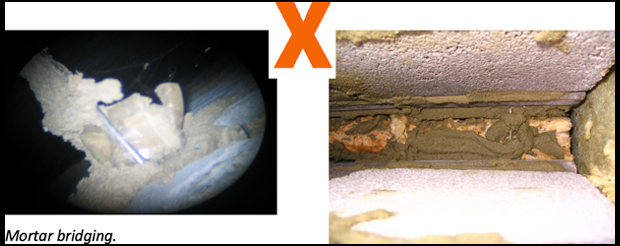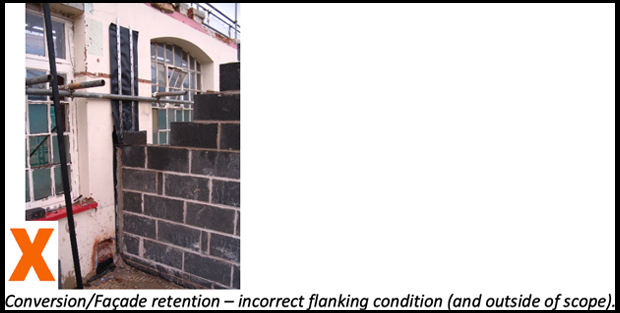Performance Monitoring Findings
Episode 2 - In a Cavity Far Far Away: a Star Walls story
In this second and final instalment looking at the trends that have been identified through the recent monitoring work, we can see that constructing a separating wall with stellar performance is not rocket science, and it certainly doesn’t have to be a battle!
As in Episode 1, links in this article will transport you to more detailed articles on each of the particular points.
Testing Masonry
One of the most commonly discovered issues continues to be mortar bridging in cavity masonry separating walls. In the wider context it’s probably not unexpected given the predominance of loadbearing masonry construction registrations, but even in terms of the relative proportions for those types of construction these issues remain the most significant. In cavity masonry separating walls, mortar bridging is considered to be a factor in 59% of instances of tests with impaired performance. As a consequence, this will always feature prominently in the feedback we provide.

For cavity masonry separating walls the use of incorrect or incorrectly installed wall ties also remains a significant issue, with almost 11% of impaired tests being attributed to this type of deviation.
The other area particularly identified related to incorrect junction detailing with the flanking elements, particularly at the external (flanking) wall and the substructure. This has included cases of building separating walls off steel beams, and incorrect roof junction details, in particularly valley gutters.

Testing Timber
In timber frame construction, separating walls are most commonly (80% of the cases) impaired through the cavity between the wall panels being less than the required 50mm. The setting out of the substructure and correct installation of the wall panels, with necessary tolerances accounted for to ensure that the minimum 50mm gap is maintained, is therefore critically important. Otherwise, the cavity being physically bridged by debris or the like was the other significant cause of impaired sound insulation performance for this wall type.
In terms of the Robust Details timber separating floors (which currently are specifically intended only for use in timber frame construction), 50% of the impaired sound tests were found to be caused by inadequately installed ceiling treatments, but in two other cases it was found that the design adopted and constructed bore no resemblance to the registered Robust Details specification.
One of these involved a masonry supported timber floor and, unsurprisingly, there was a significant impairment to the sound insulation – which explains why we always recommend seeking the advice of an acoustic consultant in cases where strict adherence to a Robust Details specification is not possible.
Inspections
The inspections, which are primarily intended as a knowledge transfer mechanism to help guide users to best practice during the construction process, also reveal similar findings in terms of the most commonly identified issues. However, other findings include:
- Inappropriate registrations for the use of Robust Details in developments that involved the conversion/refurbishment of existing buildings
- Incorrect detailing of movement joints in masonry separating walls (not in accordance with the guidance given on page 2 of Appendix A1 in the Robust Details Handbook)
- Unfilled joints and/or holes left in masonry walls
- Wall linings of incorrect specification
- Timber floating floor treatments not correctly isolated at perimeters
- Inappropriately installed services within the separating element.

Whilst not necessarily a problem, another (indeed, the most) significant finding from the inspections is the tendency for organisations to register for the use of one Robust Details type only to then build in accordance with a different Robust Details type… usually by adopting the use of different products, such as different blockwork and/or different cavity insulation or wall finishes. This can be easily rectified by undertaking an amendment to the registration details.
As a wise being once said after reading this article, “Mind what you have learned. Save you it can.”
If you have any techncial enquiries please do not hesitate to contact our technical team on 03300 882140 or email: technical@robustdetails.com
Return to the Top Tips page

